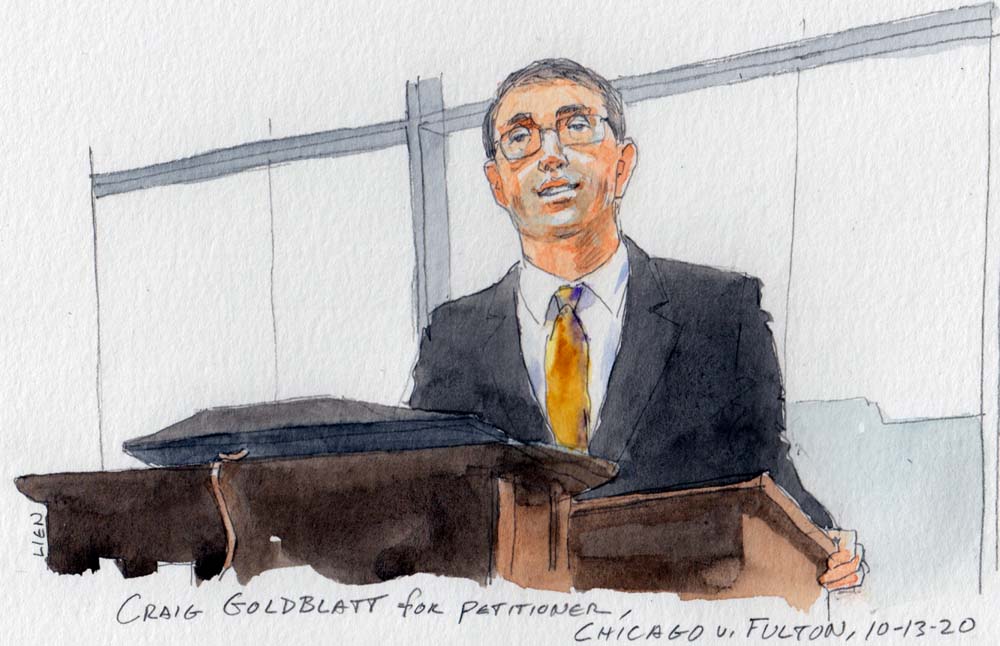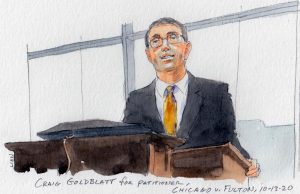Argument analysis: Bankruptcy metaphysics

on Oct 16, 2020 at 11:24 am

On Tuesday, the Supreme Court heard argument in City of Chicago v. Fulton via phone. The issue in this case is a narrow statutory question about how two sections of the U.S. Bankruptcy Code interact. With the argument tightly focused on the text of the statute, there were few fireworks to report.

Craig Goldblatt argues remotely for Chicago (Art Lien)
This case arises out of the city of Chicago’s practice of impounding cars for nonpayment of fines and fees owed to the city. To retrieve their cars, individuals must pay not only the fees owed to the city, but also the costs associated with impoundment. For many individuals, the sums they owe the city are far greater than they can pay, at least in the near term.
After their cars were impounded, Robbin Fulton, Jason Howard, George Peake and Timothy Shannon sought bankruptcy protection to help solve their financial problems with the city and to get their cars back. In all four cases, the city refused to return the cars until the debtors satisfied certain procedures that the city believed were required by § 542(a) of the bankruptcy code and the Federal Rules of Bankruptcy Procedure. The debtors believe that a different provision of the code, § 362(a)(3), obligated the city to return the cars as soon as they filed for bankruptcy relief. The bankruptcy court agreed with the debtors, ordering the city to return their cars and pay sanctions. On appeal, the U.S. Court of Appeals for the 7th Circuit agreed with the bankruptcy court, thereby cementing a circuit split with the 2nd, 8th, 9th, 11th and now the 7th Circuits on one side and the 10th and District of Columbia Circuits on the other.
Tuesday’s argument began with and continued to circle back to the action/inaction distinction. The question was whether the city violated § 362(a)(3) – which prohibits “any act to obtain possession of property of the estate or of property from the estate or to exercise control over property of the estate” – when it retained possession of the debtors’ cars after they filed for bankruptcy relief. Section 362’s stay pauses all collection actions to give the bankruptcy proceedings room to unfold without the creditors racing each other to gobble up assets. If keeping a car on an impound lot is an “act,” then the city violated the stay.
Arguing for the city, Craig Goldblatt explained that the stay, as codified in § 362, preserves the status quo of possession when it goes into effect, usually upon the filing of the bankruptcy petition. Goldblatt tried to focus on the status quo point, not the action/inaction distinction, which he dubbed “metaphysical philosophy,” but the justices, by their own admission, kept returning to the metaphysics. Chief Justice John Roberts wanted to know whether retaining a car after someone requested its return was an action. Justice Samuel Alito asked whether moving cars among impound lots would be an action. Justice Sonia Sotomayor asked about subjecting a car to weather or the chance that thieves might break in.
Colleen Roh Sinzdak argued for the United States as a “friend of the court” in support of the city. Asked if the court needed to look beyond § 362(a)(3) to decide the case, she deftly explained that it did not — keeping an impounded car need not be an act. A decision on the “metaphysics” could be the narrowest and easiest outcome. Sotomayor seemed skeptical of this approach. She asked whether a college that refused to release a transcript to a student with a balance on their account would violate the stay, as many courts have held. Sinzdak responded that courts decided the transcript cases under § 362(a)(6), which bars “any act to collect” debt. Justice Neil Gorsuch also wondered whether the city might be violating § 362(a)(6), which would allow the court to avoid the metaphysics of § 362(a)(3).
Justice Elena Kagan had some of the most challenging questions about how to frame the stay. She first questioned whether the stay was about preserving the status quo or marshaling assets for the estate. Later, she wondered if the stay at least barred creditors from keeping property that debtors want back.
The justices dug deeper into the bankruptcy code in their questions for the debtors’ counsel, retired bankruptcy judge Eugene Wedoff. They were interested in whether the 1984 amendments to the bankruptcy code, which added the phrase “exercise control” to § 362(a)(3), were meant to change bankruptcy practice. One well-established canon of construing the bankruptcy code is a strong presumption that the code does not change existing bankruptcy practice. Wedoff argued that the bankruptcy code prohibited retaining possession of an impounded car even before the 1984 amendments, but none of the justices seemed inclined to adopt this view. Nor did they seem willing to adopt the argument that the 1984 amendments changed bankruptcy practice. Gorsuch and Justice Brett Kavanaugh pushed Wedoff to explain why Congress did not add a phrase like “retain possession” if that’s what Congress meant.
The justices also had several questions for Wedoff about the role of § 542, which describes how parties in possession of debtors’ property must turn it over to bankruptcy trustees. The chief justice and Justices Clarence Thomas and Stephen Breyer questioned whether the debtors’ reading of § 362(a)(3) rendered § 542 superfluous. Breyer almost seemed annoyed at the overlapping mandates of the two sections under the debtors’ reading, exclaiming at one point, “So I can’t get the difference in my mind.”
At this point, the argument turned to why the case mattered at all. There is no doubt that a debtor could file an adversary proceeding under § 542 for return of their car, but that process might take weeks, during which a debtor would not have her car. Sotomayor, who expressed sympathy for the debtors’ need for their cars to get to work and live their lives, questioned whether § 362(a)(3) could really be read as circumventing the procedures implied in § 542 and required by the Federal Rules of Bankruptcy Procedure. She invited Wedoff to explain how Congress could amend the bankruptcy code to expedite the turnover process for vehicles. He responded that “there could be language added to Section 362(a)(3) that made it abundantly clear that the interpretation that we’re proposing right now is the correct one,” to which she replied, “All right. You’re not helping. Okay.”
Looking beyond the narrow statutory issues in the case, there are many reasons to question the ethics and wisdom of Chicago’s impoundment policies. The perversity of withholding someone’s transportation to work as a means to squeeze money out of them bubbled up at various intervals in the argument. No bankruptcy case can fix that. If bankruptcy procedure is exacerbating debtors’ distress, the answer is to streamline bankruptcy procedure through amendments to the code or the Federal Rules of Bankruptcy Procedure. Debtors want the court to believe that is what Congress did in the 1984 amendments, but the justices did not sound convinced.


